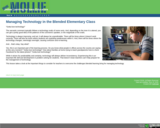
Managing Technology in the Blended Elementary Class
- Subject:
- Education
- Material Type:
- Activity/Lab
- Reading
- Provider:
- AEA Learning Online
- Provider Set:
- OLLIE
- Author:
- Evan Abbey
- Date Added:
- 01/13/2021

Managing Technology in the Blended Elementary Class
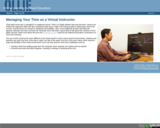
Managing Your Time as a Virtual Instructor
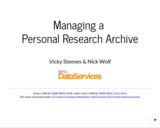
A class on setting up and managing research materials; caring for digital files to enable collaboration, sharing, and re-use; and helpful software/digital tools for organizing personal research files.
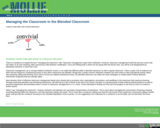
Managing the Classroom in the Blended Elementary Class
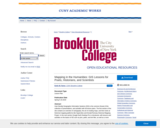
User-friendly Geographic Information Systems (GIS) is the common thread of this collection of presentations, and activities with full lesson plans. The first section of the site contains an overview of cartography, the art of creating maps, and then looks at historical mapping platforms like Hypercities and Donald Rumsey Historical Mapping Project. In the next section Google Earth Desktop Pro is introduced, with lessons and activities on the basics of GE such as pins, paths, and kml files, as well as a more complex activity on "georeferencing" an historic map over Google Earth imagery. The final section deals with ARCGIS Online and StoryMaps with tutorials, basic exercises on pins, paths, and CSV import, and a lesson plan for creating a research project presentation on an historic building in StoryMaps. In addition to an xml file that has been uploaded here to Academic Works, the module is also a live website at https://libguides.brooklyn.cuny.edu/cs-x. The site was created with Libguides software, and is a Community Libguide that can be reused and imported into other LibGuides sites. The website also contains links to two live StoryMaps, one on an Introduction to ARCGIS StoryMaps (https://arcg.is/1SX1zH), and the second, a model assignment on the history of the Fairway building in Red Hook, Brooklyn (https://arcg.is/1nbHP).
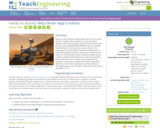
Based on their experience exploring the Mars rover Curiosity and learning about what engineers must go through to develop a vehicle like Curiosity, students create Android apps that can control LEGO MINDSTORMS(TM) NXT robots, simulating the difficulties the Curiosity rover could encounter. The activity goal is to teach students programming design and programming skills using MIT's App Inventor software as the vehicle for the learning. The (free to download) App Inventor program enables Android apps to be created using building blocks without having to actually know a programming language. At activity end, students are ready to apply what they learn to write other applications for Android devices.
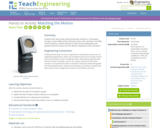
Students learn about slope, determining slope, distance vs. time graphs through a motion-filled activity. Working in teams with calculators and CBL motion detectors, students attempt to match the provided graphs and equations with the output from the detector displayed on their calculators.
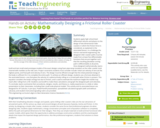
Students apply high school-level differential calculus and physics to the design of two-dimensional roller coasters in which the friction force is considered, as explained in the associated lesson. In a challenge the mirrors real-world engineering, the designed roller coaster paths must be made from at least five differentiable functions that are put together such that the resulting piecewise curving path is differentiable at all points. Once designed mathematically, teams build and test small-sized prototype models of the exact designs using foam pipe wrap insulation as the roller coaster track channel with marbles as the ride carts.
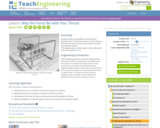
In this lesson, students will study how propellers and jet turbines generate thrust. This lesson focuses on Isaac Newton's 3rd Law of Motion, which states that for every action there is an equal and opposite reaction.
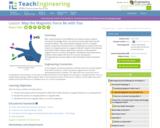
This lesson begins with a demonstration of the deflection of an electron beam. Students then review their knowledge of the cross product and the right hand rule with sample problems. After which, students study the magnetic force on a charged particle as compared to the electric force. The following lecture material covers the motion of a charged particle in a magnetic field with respect to the direction of the field. Finally, students apply these concepts to understand the magnetic force on a current carrying wire. Its associated activity allows students to further explore the force on a current carrying wire.
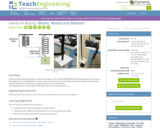
Students experience data collection, analysis and inquiry in this LEGO® MINDSTORMS® NXT -based activity. They measure the position of an oscillating platform using a ultrasonic sensor and perform statistical analysis to determine the mean, mode, median, percent difference and percent error for the collected data.
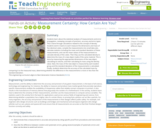
Students learn about the statistical analysis of measurements and error propagation, reviewing concepts of precision, accuracy and error types. This is done through calculations related to the concept of density. Students work in teams to each measure the dimensions and mass of five identical cubes, compile the measurements into small data sets, calculate statistics including the mean and standard deviation of these measurements, and use the mean values of the measurements to calculate density of the cubes. Then they use this calculated density to determine the mass of a new object made of the same material. This is done by measuring the appropriate dimensions of the new object, calculating its volume, and then calculating its mass using the density value. Next, the mass of the new object is measured by each student group and the standard deviation of the measurements is calculated. Finally, students determine the accuracy of the calculated mass by comparing it to the measured mass, determining whether the difference in the measurements is more or less than the standard deviation.
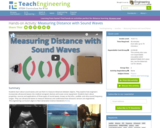
Students learn about sound waves and use them to measure distances between objects. They explore how engineers incorporate ultrasound waves into medical sonogram devices and ocean sonar equipment. Students learn about properties, sources and applications of three types of sound waves, known as the infra-, audible- and ultra-sound frequency ranges. They use ultrasound waves to measure distances and understand how ultrasonic sensors are engineered.
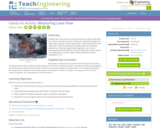
Students learn how volume, viscosity and slope are factors that affect the surface area that lava covers. Using clear transparency grids and liquid soap, students conduct experiments, make measurements and collect data. They also brainstorm possible solutions to lava flow problems as if they were geochemical engineers, and come to understand how the properties of lava are applicable to other liquids.
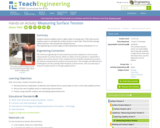
Students observe capillary action in glass tubes of varying sizes. Then they use the capillary action to calculate the surface tension in each tube. They find the average surface tensions and calculate the statistical errors.
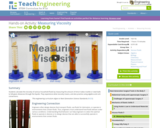
Students calculate the viscosity of various household fluids by measuring the amount of time it takes marble or steel balls to fall given distances through the liquids. They experience what viscosity means, and also practice using algebra and unit conversions.
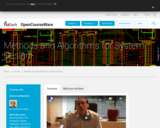
System design is the central topic of this course. We move beyond the methods developed in circuit design (although we shall have interest in those) and consider situations in which the functional behavior of a system is the first object under consideration.
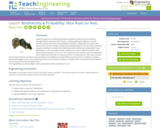
Students explore the relationships between genetics, biodiversity, and evolution through a simple activity involving hypothetical wild mouse populations. First, students toss coins to determine what traits a set of mouse parents possesses, such as fur color, body size, heat tolerance, and running speed. Next they use coin tossing to determine the traits a mouse pup born to these parents possesses. These physical features are then compared to features that would be most adaptive in several different environmental conditions. Finally, students consider what would happen to the mouse offspring if those environmental conditions were to change: which mice would be most likely to survive and produce the next generation?
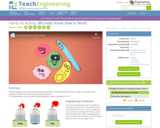
Students design systems that use microbes to break down a water pollutant (in this case, sugar). They explore how temperature affects the rate of pollutant decomposition.
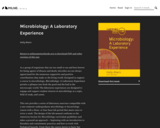
As a group of organisms that are too small to see and best known for being agents of disease and death, microbes are not always appreciated for the numerous supportive and positive contributions they make to the living world. Designed to support a course in microbiology, Microbiology: A Laboratory Experience permits a glimpse into both the good and the bad in the microscopic world. The laboratory experiences are designed to engage and support student interest in microbiology as a topic, field of study, and career. This text provides a series of laboratory exercises compatible with a one-semester undergraduate microbiology or bacteriology course with a three- or four-hour lab period that meets once or twice a week. The design of the lab manual conforms to the American Society for Microbiology curriculum guidelines and takes a ground-up approach -- beginning with an introduction to biosafety and containment practices and how to work with biological hazards. From there the course moves to basic but essential microscopy skills, aseptic technique and culture methods, and builds to include more advanced lab techniques. The exercises incorporate a semester-long investigative laboratory project designed to promote the sense of discovery and encourage student engagement. The curriculum is rigorous but manageable for a single semester and incorporates best practices in biology education.